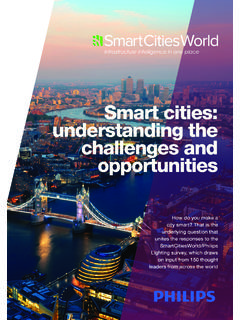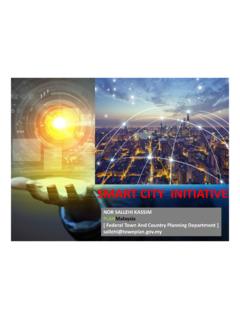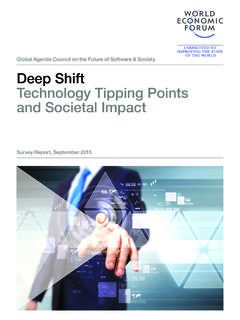Transcription of Ethical and Social Aspects of Self-Driving Cars - arXiv
1 Ethical and Social Aspects of Self-Driving Cars Tobias Holstein Gordana Dodig-Crnkovic, Patrizio Pelliccione M lardalen University Chalmers University of Technology | University of V ster s, Sweden Gothenburg Gothenburg, Sweden ABSTRACT with Intelligent Transport Systems (ITS), Smart Cities, and Inter- As an envisaged future of transportation, Self-Driving cars are being net of Things (IoT). Self-Driving vehicles will combine data from discussed from various perspectives, including Social , economical, inside vehicle with external data coming from the environment (other vehicles, the road, signs, and the cloud). In such a scenario, [ ] 5 Feb 2018. engineering, computer science, design, and ethics. On the one hand, Self-Driving cars present new engineering problems that are being different applications will be possible: smart traffic control, better gradually successfully solved.
2 On the other hand, Social and Ethical platooning coordination, and enhanced safety in general. How- problems are typically being presented in the form of an idealized ever, the basic assumption is that future Self-Driving connected unsolvable decision-making problem, the so-called trolley problem, cars must be socially sustainable. A typical discussion about Ethical which is grossly misleading. We argue that an applied engineering Aspects of Self-Driving cars starts with Ethical thought experiment, Ethical approach for the development of new technology is what so called trolley problem described in [29] and [66], that has been is needed; the approach should be applied, meaning that it should discussed in number of articles in IEEE [7, 9, 33], ACM [30, 40, 43], focus on the analysis of complex real-world engineering problems.
3 Scientific American [16, 37, 41], Science [11, 36], other high-profile Software plays a crucial role for the control of Self-Driving cars; journals [14, 32, 34], conference workshops [8, 50] and other sources therefore, software engineering solutions should seriously handle [2, 6, 44, 54]. Here is the general scenario being discussed: Ethical and Social considerations. In this paper we take a closer A Self-Driving vehicle drives on a street with a high speed. In front look at the regulative instruments, standards, design, and imple- of the vehicle a group of people suddenly blocks the street. The vehicle mentations of components, systems, and services and we present is too fast to stop before it reaches the group. If the vehicle does not react practical Social and Ethical challenges that have to be met, as well immediately, the whole group will be killed.
4 The car could however as novel expectations for software engineering. evade the group by entering the pedestrian way and consequently killing a previously not involved pedestrian. The following alternations of the problem exist: (A) Replacing the pedestrian with a concrete wall, CCS CONCEPTS. which in consequence will kill the passenger of the Self-Driving car;. Computer systems organization Embedded systems; Re- (B) Varying the personas of people in the group, the single pedestrian dundancy; Robotics; Networks Network reliability; or the passenger. The use of personas allows including an emotional perspective [10], , stating that the single pedestrian is a child, a KEYWORDS relative, a very old or a very sick human, or a brutal dictator, who Self-Driving Cars, Autonomous Cars, Trolley Problem, Decision killed thousands of people.
5 Making, Ethics, Social Aspects , Software Engineering, Challenges Even though the scenarios are similar, the responses of humans, when asked how they would decide, differ [11]. The problem is that the question asked has limited number of possible answers, 1 INTRODUCTION which are all ethically questionable and perceived as bad or wrong. Increasingly, prototypical Self-Driving vehicles are participating in Therefore, a typical approach to this problem is to analyze the public traffic [48] and are planned to be sold starting in 2020 [56, 61]. scenarios by following Ethical theories, such as utilitarianism, other Public awareness and media coverage contribute to a manifold of forms of consequentialism or deontological ethics [42]. For example, discussions about Self-Driving vehicles. This is currently amplified utilitarianism would aim to minimize casualties, even if it means to through recent accidents with autonomous vehicles [24, 58].
6 Kill the passenger, by following the principle: the moral action is the Software is playing a key role in modern vehicles and in self - one that maximizes utility (or in this case minimizes the damage). driving vehicles. Gigabytes of software run inside the Electronic Depending on the ethics framework, different arguments can be Control Units (ECUs), which are small computers embedded in used to justify the decision. the vehicle. The number of ECUs has grown in the last 20 years Applying Ethical doctrines to analyze a given dilemma and pos- from 20 to more than 100. Software in cars is growing by a factor sible answers can presently only be done by humans. How would of 10 every 5 to 7 years, and in some sense car manufacturers Self-Driving cars solve such dilemmas? There are a number of publi- are becoming software companies [47].
7 These novelties ask for a cations that suggest to implement moral principles into algorithms change on how the software is engineered and produced and for a of Self-Driving cars [17, 18, 33]. We find that this does not solve the disruptive renovation of the electrical and software architecture of problem, but it reassures that the solution is calculated based on the car, as testified by the effort of Volvo Cars [47]. a given set of rules or other mechanisms, moving the problem to Moreover, Self-Driving vehicles will be connected with other ve- engineering, where it is implemented. hicles, with the manufacturer cloud, , for software upgrades, arXiv '18, January 2018, Gothenburg, Sweden Tobias Holstein and Gordana Dodig-Crnkovic, Patrizio Pelliccione It is worth to notice that the engineering problem is substantially Focusing on important Ethical challenges that should currently different from the hypothetical Ethical dilemma.
8 While an Ethical be addressed and solved is an important step before Ethical Aspects dilemma is an idealized constructed state that has no good solution, of Self-Driving cars can actually be meaningfully discussed from an engineering problem is always by construction such that it can the point of view of societal and individual stakeholders as well as differentiate between better and worse solutions. A decision mak- designers and producers. It is important to focus not on abstract ing process that has to be implemented in a Self-Driving car can be thought experiments but on concrete conditions that influence summarized as follows. It starts with an awareness of the environ- the behavior of Self-Driving cars and their safety as well as our ment: Detecting obstacles, such as a group of humans, animals or expectations from them.
9 Buildings, and also the current context/situation of the car using The paper is structured as follows. A short introduction to self - external systems (GPS, maps, street signs, etc.) or locally available driving cars and their current state of the art is provided in Section 2, information (speed, direction, etc.). Various sensors have to be used with the emphasis on the description of the decision making prin- to collect all required information. Gaining detailed information ciples given in Section and the role of software in Section about obstacles would be a necessary step before a decision can be Ethical and Social challenges are addressed in Section 3 regarding made that maximizes utility and/or minimizes damage. A computer technical Aspects , and Section 4 addressing Social Aspects . Section 5.
10 Program calculates solutions and chooses the solution with the op- describes the current state of norms and standards, while conclu- timal outcome. The Self-Driving car executes the calculated action sions and final remarks are presented together with recommenda- and the process repeats itself. tions in Section 6. The process itself can be used to identify concrete Ethical chal- lenges within the decision making by considering the current state 2 Self-Driving CARS BASICS. of the art of technology and its development. In a concrete car The term "autonomous" could be ambiguous to some readers. It both the parts of this complex system and the way in which it is can be used to describe certain autonomous features or functions, created have a critical impact on the decision-making. This includes such as advanced driver assistance systems, that for example assist for instance the quality of sensors, code, and testing.

![arXiv:0706.3639v1 [cs.AI] 25 Jun 2007](/cache/preview/4/1/3/9/3/1/4/b/thumb-4139314b93ef86b7b4c2d05ebcc88e46.jpg)

![arXiv:1301.3781v3 [cs.CL] 7 Sep 2013](/cache/preview/4/d/5/0/4/3/4/0/thumb-4d504340120163c0bdf3f4678d8d217f.jpg)
![@google.com arXiv:1609.03499v2 [cs.SD] 19 Sep 2016](/cache/preview/c/3/4/9/4/6/9/b/thumb-c349469b499107d21e221f2ac908f8b2.jpg)










